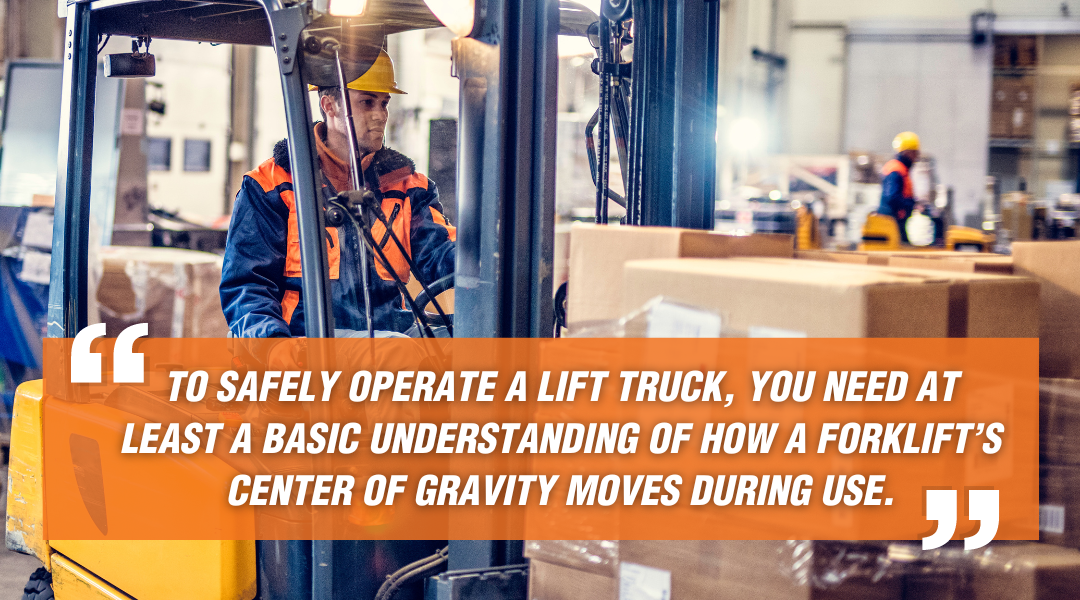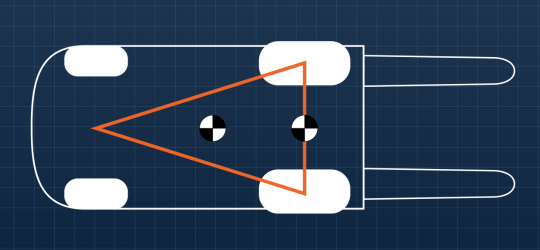We use cookies to make your experience better. To comply with the new e-Privacy directive, we need to ask for your consent to set the cookies. Learn more.
Managing the Forklift Center of Gravity, According to OSHA
Operating forklifts — or even working around them — can be dangerous. In 2021, 70 workers lost their lives in forklift accidents. The previous year, more than 7,000 people were injured. According to the National Safety Council, more than half of these forklift injuries were the result of “transportation incidents.”
What type of transportation incidents cause serious workplace injuries? A commonly cited study from the Centers for Disease Control (CDC) says forklift overturns are the leading cause of forklift fatalities. In the 1990s, tipping forklifts caused a quarter of all fatal injuries involving industrial trucks. The CDC’s data is old, but the caution it recommends is timeless.

You don’t need a steep ramp or a dock accident to tip your forklift. If you’re not careful, gravity alone will do the trick. The trouble is, gravity’s pull on your truck shifts under load. To safely operate a lift truck, you need at least a basic understanding of how a forklift’s center of gravity moves during use. That’s what this post is all about.
An Introduction to the Forklift Center of Gravity
As we mentioned in our coverage of the forklift stability triangle, counterbalance forklift suspensions generally support the truck’s weight at three points:
- Centered under the rear left tire
- Centered under the rear right tire
- At the midpoint between the front two tires
These three points make a triangle. An unloaded forklift’s center of gravity rests somewhere within the boundary of this triangle.
So what exactly do we mean by the center of gravity? The Occupational Safety and Health Administration (OSHA) supplies a technical definition for this important term:
OSHA Standard 1910.178, Appendix A: “Center of gravity is the point on an object at which all of the object’s weight is concentrated. For symmetrical loads, the center of gravity is at the middle of the load.”
A counterbalance forklift is generally symmetrical laterally, or from one side to the next — but not longitudinally, or from front to back. That’s because of the heavy ballast at the rear of the truck. In an electric forklift, the battery itself provides this ballast.
This is by design. Placing more weight at the rear of the truck shifts the center of gravity backwards, toward the ballast. That helps to counteract the weight of loads when you elevate materials on front forks. And your forklift’s center of gravity helps to explain why ballast is so important for sit-down, counterbalance trucks.
Understanding How Forklift Center of Gravity Shifts Under Load
A forklift’s center of gravity always falls between multiple sources of weight. When you pick up a load, you add a new source of weight — and you add it at the far end of your lift truck. Your center of gravity is no longer based on the weight distribution of your truck itself. It now includes the load, too.
A forklift’s center of gravity can shift forward, backward, right, left, and up or down. When you lift loaded forks higher, the upward shift can pull your truck forward — resulting in a forward tip, if you’re not careful. That’s why OSHA instructs forklift operators to carry loads no higher than four to six inches (10.16 to 15.24 centimeters) off the ground.
In addition to keeping loads low during travel, forklift operators can maintain a stable center of gravity by following, at minimum, these OSHA-recommended practices:
- Never try to lift a load that surpasses the trucks’ stated capacity. You can find this capacity on the lift truck’s data plate. (OSHA Standard 1910.178[o][2])
- Position loads as close to the truck carriage as possible. If the load is asymmetrical, put the heaviest edge of the load closest to the carriage. (OSHA eTool: Powered Industrial Trucks [Forklift])
- If you must lift irregular loads — such as extra-wide objects or items that are heavier in one part than another — position forks to distribute weight evenly. (OSHA Standard 1910.178, Appendix A)
- Tilt masts back to keep loads over front wheels, or as close to that as you can get, before traveling. (OSHA eTool: Powered Industrial Trucks [Forklift]).
- Elevation changes also shift your center of gravity. When traveling on a ramp with a grade over 10 percent, keep the load facing the higher end of the ramp. That is, drive forward when ascending, and backward when descending, a ramp. This is applicable whenever you travel with loaded forks. (OSHA Standard 1910.178[n][7][i]).
These tips are by no means the only directions for managing your forklift center of gravity. That’s why OSHA requires initial and ongoing training for all forklift operators. Learn more about OSHA forklift training programs here.
And if you have questions about handling the forklift batteries that both power and provide ballast to electric, counterbalance forklifts — and other industrial trucks — contact the battery handling experts at BHS, Inc.

